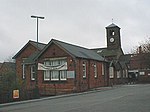Clay Cross and Egstow railway station
Disused railway stations in DerbyshireFormer London, Midland and Scottish Railway stationsPages with no open date in Infobox stationUse British English from January 2021

Clay Cross and Egstow railway station the terminus of the Ashover Light Railway and it served the Egstow area of Clay Cross, North East Derbyshire, England. The station had an unusually large nameboard (10 ft by 3 ft) which stood on the single low platform. There was a wooden station building consisting of an open-fronted wooden shelter, which had the manager's office on one side, and on the other what was intended as a parcels office, but was actually used as a general storeroom. The station was the only one on the line to enjoy electric lighting. After closure in 1950. The site was demolished and is now occupied by a road called Bridge Street.
Excerpt from the Wikipedia article Clay Cross and Egstow railway station (License: CC BY-SA 3.0, Authors, Images).Clay Cross and Egstow railway station
Bridge Street, North East Derbyshire Holmgate
Geographical coordinates (GPS) Address Nearby Places Show on map
Geographical coordinates (GPS)
| Latitude | Longitude |
|---|---|
| N 53.172541 ° | E -1.407836 ° |
Address
Bridge Street
Bridge Street
S45 9TT North East Derbyshire, Holmgate
England, United Kingdom
Open on Google Maps









